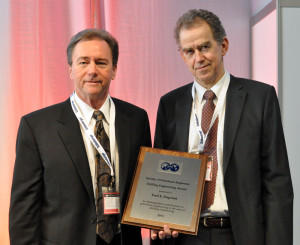2013 SPE Drilling Engineering Award recipient Dupriest pushes for more engineering, less optimization
By Joanne Liou, associate editor

Specifically changing the way a job is done, rather than flawlessly executing the job the way it’s always been done, has led to many of ExxonMobil’s successes, Fred Dupriest said in accepting the 2013 SPE Drilling Engineering Award on 5 March at the SPE/IADC Drilling Conference & Exhibition in Amsterdam. “You’ve got to address a lot of things about yourself and how you work,” said Mr Dupriest, who recently retired after 24 years in field operations, followed by 12 years with ExxonMobil supporting drill teams in well planning and trouble response. He is the 30th recipient of the drilling engineering award, which recognizes outstanding achievement and contributions to the advancement of petroleum engineering in the area of drilling engineering technology. “He is a shining example of how we continue to advance in our industry,” 2013 Drilling Conference chairman Øystein Arvid Håland, head of drilling & well for Statoil and a senior representative for SPE, said as he presented Mr Dupriest with the award.
Mr Dupriest expressed his pride in the industry, noting that ExxonMobil in particular has doubled its average footage per day in the last eight years. “At the same time, our well complexity has gone through the roof,” he explained. “We drilled 24 of the 30 longest wells in the world, and those 24 wells had less than 10% trouble costs on average.” The successes have been an accumulation of many factors, and “it’s been a workflow that we call limiter redesign. It’s a simple idea,” he noted. A limiting factor is identified and worked on until another factor becomes the limiter and needs to be worked on. “You keep doing that until you reach the economic limit of redesign.”
He shared four principles that have helped ExxonMobil become a leading performer:
1. Death to optimization. Industry must place more focus on engineering than on optimization, Mr Dupriest advocated. The industry is too used to defining what the boundaries are and snuggling up to them, he continued. In borehole stability, for example, when mud weight is raised, differential sticking and formation damage become a concern that is often pushed until “you start feeling a little bit more pain and start backing up. Then, there we are, and there we stay when we optimize,” he noted.

By looking at the physics of formation damage, deterministically and not empirically, ExxonMobil found that things did not work the way they thought, based on empirical data. “Even though we raised mud weight, we simultaneously reduced formation damage dramatically by looking at physics,” Mr Dupriest stated. “Don’t optimize before you’ve reengineered your limiters. Engineer first, and optimize second.”
2. Death to empiricism; make decisions deterministically. Creating change goes beyond studying the status quo or data of how work is done and how people behave. In Mr Dupriest’s career, he has experienced an average of 15% to 20% trouble times in complex wells; however, since redesigning limits, the average has dropped by approximately 5%. Finding the balance between establishing standards and cultivating change is a challenge. “Empiricism is a problem. In some sense, we need standardized equipment; we need standardized practices. We need operational manuals, well control manuals,” he said, but “we need to understand that same culture that makes us really good is also the same culture that makes us resistant to change.
3. Trust in people. The answer to figuring out the physics of an operation might be found in a published paper or study, but the next step is to put it into practice with people – in particular, the people who actually drill the well, i.e., the driller or directional driller. Referring to what he called the “50/20/30 Rule,” Mr Dupriest explained that studies show approximately 50% of your employees will always do the right thing even at a cost or difficulty, and 20% more, in the right environment and under management that is facilitating and supporting the decision, will follow. Approximately 30% of people will not go along, simply because it is not in their nature. However, this lagging group will follow once the majority establishes what is right. “When you look at creating change, it’s that 50% you need to trust and believe in. Teach them how things really work. Study how things work and commit to those practices.”
4. Get out of the way. To enable change to happen, it is important for company leadership to present a path free of roadblocks. “Look at your company and see what it is about how you work and what gets in people’s way,” Mr Dupriest said. The challenges vary among companies and different business models, but it’s part of leadership’s role to strategically change the workflow to create change. “You really have to mechanically change pieces of your workflow so that people are always encouraged, supported or mechanically driven to identify limits and what they’re going to do to change it.”





To Joanne Liou
I just saw this. I made this presentation, and your synopsis is so much better than what I said. I get requests to repeat this presentation. I may just send them your summary.
Just wanted to let you know how much I appreciate the thought you put into this.
Take Care